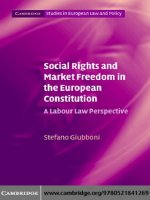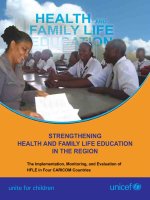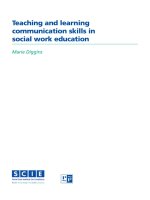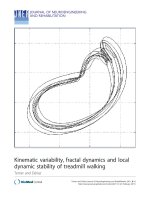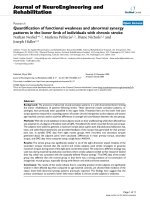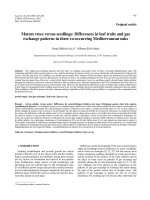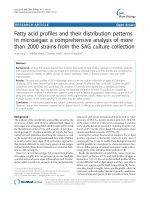Social dynamics and local trading patterns in bantaeng region, south sulawesi (indonesia) circa 17th century 5
Bạn đang xem bản rút gọn của tài liệu. Xem và tải ngay bản đầy đủ của tài liệu tại đây (5.15 MB, 68 trang )
228
Chapter 5
Archaeological Evidence for Bantaeng’s Rise and Decline
as a Center of Long Distance Maritime Trade
and the Impact of these Changes on Artifact Distribution
Inter-island trade was probably at least as significant as long-distance trade in shaping
local societies in Indonesia, if not more so. Trading centers in Sumatra and Java played
significant roles in Bali, Nusa Tenggara, and Maluku, while Malukan, Buginese, and
Makassarese traders played essential roles in inter-island trading activity (Cortesao 1944;
Schrieke 1955; van Leur 1960; Meilink-Roelofs 1962; Wolters 1967; Reid 1988; 2000;
Leirisa 1994; Nayati 1994; 1998a). Such trading systems were not restricted to collecting
products from peripheral areas or for local consumption; Macknight (1975) discovered that
South Sulawesi people collected sea cucumber from Northern Australia for the Chinese
consumers in circa 18
th
century while Sulawesi seamen smuggled spices to Makassar, which
then shipped them to Asia and European ports (Sutherland and Bree 1976).
Gowa and the VOC both prevented Bantaeng from carrying on direct contact with
other regions. This coastal blockade affected the elite group who needed imported items for
burial goods and prestige markers. This change occurred simultaneously with the introduction
of Islam, but evidence suggests that old customs did not change drastically. Burials of the
17
th
-18
th
centuries such as the Ma’jombe and La Tenri Ruwa royal graves still have important
meanings for the local society. The La Tenri Ruwa royal graves are found within a radius of
1 km from the vanished Ballaq Lompoa in Kalimbaung and Bissampole, and near Letta
Ballaq Lompoa in Bantaeng city. Graves in the La Tenri Ruwa royal burial complex have
229
similar characteristics to the burial complex at Tamalate (Gowa regency), Tanete Rilau (Barru
regency), and Lamuru (Bone regency) (Suaka Peninggalan Sejarah dan Purbakala 1984).
Caldwell (1992, 2000) used Lontaraq (local manuscripts) to interpret links between
political organizations. Lontaraq, local manuscript/chronicles written in Makasar-Bugis
scripts, is believed to have been composed around 1300, but rewritten, edited, and published
around in 1900 (Caldwell 1988; Cumming 1999, 2000, 2002 Koolhof 1999). Lontaraq
mention Tomanurung legends, treaties, genealogical records, and adat. Caldwell analyzed
the distribution of vassals of Luwu’, Sopeng, and Sidenreng political organizations in the
northern part of what is now south Sulawesi province, from the genealogies of royal families.
Caldwell’s hypothesis on the evolution of political organization in South Sulawesi is suggestive
but difficult to prove with archaeological data compared to political organization in Java in
circa 16
th
century, as such indicators of royal residence as the Gaukang consist of moveable
items and the Ballaq Lompoa were built from perishable materials. Moreover the Lontaraq
has rewritten by many people for personal purposes, which are difficult to judge. In addition,
as data from Bantaeng show, Gaukang have been created after DI-TII, therefore
Tomanurung legends can possibly be recently created while Lontaraq on Bantaeng have
been created at the instigation of the Karaeng. Those two sacred items can no longer be
easily explored as Andi Masualle—an important resource person in Bantaeng who possessed
Lontaraq and had much knowledge of the history of Bantaeng—passed away. In this study,
only Lontaraq from Mappatan have been explored, a limitation on the study of the evolution
of Bantaeng which further research in future might succeed in overcoming.
Archaeologists are interested in examining the evolution of complex society, but
progress in this area has been slow. Junker (1999) analyzed political development in Bais,
230
Philippines in the 16
th
century. The evolution of political organization can be interpreted from
the archaeological evidence for burial goods and ceremonial activity. Despite the sparse
archaeological data, evidence on political development on Bantaeng can be very useful in
detecting exchange activity during the development of political activity in Bantaeng.
1. Bantaeng: the Growth of Political Organization
Two Tomanurungs are said to have descended in Bantaeng—in Onto and in Lembang
Gantarangkeke. The Tomanurung concept, which is a common phenomenon in South
Sulawesi (Noorduyn 1965; Andaya 1975; Pelras 1985), is related to the origin of dynasties
in south Sulawesi political organization (Noorduyn 1965; Andaya 1975; Mattulada 1985;
Pelras 1985; Caldwell 1988; Cummings 1999, 2000, 2002). Bantaeng’s status as a vassal
of Majapahit may have affected its development, but it can still be regarded as a typical
example of South Sulawesi political organization.
Lembang Gantarangkeke and Gantarangkeke make use of myths to legitimize their
power. On one hand they used Tomanurung legends, and on the other they draw on the I
La Galigo epic. I La Galigo is the son of Sawerigading, Luwu’s ruler who traveled and
experienced various adventures in Sulawesi.
Sawerigading is the main hero in the I La Galigo epic (Mattulada 1974; Koolhof
1999). The Sawerigading legend can be connected to the Tomanurung legend, as both
involve the underworld and upper world. According to the Tomanurung belief gods from
the upper world descend into the world of chaos. After the world becomes a better place,
the Tomanurung ascends but first passes leadership to a chosen person. Usually that person
231
obtains material things from the Tomanurung such as weapons—which become Gaukang
of the group.
He is Batara Guru’s grandson who returned to Luwu’ after traveling to various parts
of the universe including Pa’jukukang (located in Bantaeng region). However he fell in love
with his twin sister Tenriabeng, which forced him to leave Luwu. He married a princess of
Cina named We Cudaiq. Sawerigading and We Cudaiq and their son, I La Galigo, then
returned to Luwu. Their ship sank and Sawerigading and We Cudaiq became rulers of
Underworld, while I La Galigo became a ruler of Upper-world (Koolhof 1999).
The Pa’jukukang ceremony is related to the reunion of I La Galigo with the female
ruler of Lembang Gantarangkeke (Mappatan 1995). I La Galigo had visited Pa’jukukang
and married Princess Lembang Gantarangkeke but then I La Galigo left her to visit other
places. I La Galigo visited again Pa’jukukang (at the mouth of Salo Nipa-Nipa) in Bantaeng,
and organized cockfights as he did in every place he visited. The cockerel belonging to the
ruler of Lembang Gantarangkeke, who dressed up like a male, defeated I La Galigo’s
cockerel. I La Galigo was of course surprised when he found that the “male” was his wife.
The reunion of Lembang Gantarangkeke’s ruler with I La Galigo in Pa’jukukang is
ceremonially commemorated every Sya’ban according to the Islamic calendar. This implies
that Lembang Gantarangkeke has close affinities to Luwu. However, Lembang
Gantarangkeke-Gantarangkeke people speak Bugis language—similar to Bulukumba. This
implies that Lembang Gantarangkeke and Gantarangkeke voluntarily became part of ‘Tanah
Bone’. This is difficult to trace from archaeological artifacts, but legend and epic imply a
relation between Lembang Gantarangkeke-Gantarangkeke, Luwu, and Bone.
232
Lembang Gantarangkeke-Gantarangkeke has two Ballaq Lompoa and two Saukang.
This political unit occupied villages: Nipa-Nipa, Rappoa, Biangkeke, Taruttu’ (now Kiling-
Kiling/Borong Kapala), Biang Loe, Lonrong, Banyorang, Sapa-sapa, Campaga,
Gantarangkeke, Barua/Jannayya, Lembang Galung, and Moti. All those names are recognized
but only Lembang Gantarangkeke and Gantarangkeke have Ballaq Lompoa, Saukang
and related material culture while in Kiling-kiling only material culture is found, without
indication of Ballaq Lompoa and Saukang.
A Tomanurung descended in Onto. According to the Lontaraq there were seven
groups in Bantaeng area, each settlement under a leader with the title To Mangada (Mappatan
1995). Tomanurung then lived in Bissampole, now located in Bantaeng city. Two people
followed the Tomanurung from Karatuwang: Pole and To ni Gallaraka, who represented
the seven settlements. In short, the settlements became 12: Bissampole, Mappilawing,
Tangnga-Tangnga, Tompong, Tama’langnge, Mamampang, Katapang, Morowa, Bunglowe,
233
Tini, Tabaringan, and Karuntung. After the Tomanurung re-ascended: Pole, To ni Gallaraka,
and 12 To Mangada chose a person from Karatuwang, named Masanigaya, to be their
leader as Karaeng Bantaeng. Later, 12 kampong leaders became Sampulungrua or 12
Adat (12 sets of customary behavior). All these settlements are located at or around Bantaeng
city. There are Ballaq Lompoa in Bantaeng city area such as in Tompong and Letta, and
two other Ballaq Lompoa built in Kalimbaung and Bissampole later burned.
Rulers in Bantaeng inherited the throne in direct succession from father to son. Karaeng
Bantaeng VII, named Majombe, was the first ruler to convert to Islam (Mappatan 1995),
interpreted as having taken place in the early 17
th
century.
Nevertheless, Bantaeng political organization did not extend to the Panaikang area
(now located in Bissapu district of Bantaeng regency), as Panaikang was part of the Binamu
political unit (Caldwell, 2000), which now is part of Jeneponto regency.
Table 3: List of rulers in Bantaeng political organization
1.
Masanigaya Muranawa (Karaeng-1)
2.
Massanigaya Maredaya (anak Masanigaya Murana) ( He became Karaeng-2)
3.
Massanigaya Maradaiya (son of Karaeng -2. He became Karaeng-3).
4.
Jagonga (Karaeng-4) married to Dampang Sinowa
5.
Punta Dolanga / Karaeg Baineya (son of Karaeng-4. He became Karaeng-
5).
During this time, Tomanurung descended in Onto. He created Ada Sampuru
Ruwa
6.
Karaeng Rewata (son of Karaeng-5. He became Karaeng-6). He built Benteng
Baturera or Benteng Batu Terang
7.
Majombea (son of Karaeng-6. He became Karaeng-7). Bantaeng became
Islamic state
8.
Tuni Taba (son of Karaeng-7. He became Karaeng-8)
9.
Tumaparisi Bokona (Karaeng-9)
234
10.
Tutinrowa Rijalanjang (son of Karaeng-9. He became Karaeng-10)
11.
Tutinrowa Rimarajilea/Daeng Rimoncong (son of Karaeng-10. He became
Karaeng-11)
12.
Daeng Bonang (son of Karaeng-10, sibling of Karaeng-11. He became Karaeng-
12)
13.
Daeng Mangalle (son of Karaeng-12. He became Karaeng-13)
14.
Daeng Mamangasi (sibling of Karaeng-12 and Karaeng-11. He became
Karaeng-14)
15.
Ilaki (son of Karaeng-14. he became Karaeng-15)
16.
Mampalumpa Daeng Magassin (grandson of Karaeng-15. He became Karaeng-
16).
17.
Mapaturu Daeng Malungga (grandson of Karaeng-16. He became Karaeng-17)
18.
Ibagala Daeng Mallanga /Nijalloka (sibling of Karaeng-15, son of Karaeng-14.
he became Karaeng-18)
19.
I Nace (Karaeng-19)
20.
Daeng Magassin (Karaeng-20 was formerly Karaeng-16)
21.
Daeng Pasau (Karaeng-21)
22.
Karaeng Basunu (Karaeng-22)
23.
Karaeng Butung (Karaeng-23)
24.
Karaeng Panawang (Karaeng-24. Bantaeng became Regent van Bonthain)
During his reigned Torawang and Rumbia was still part of Bantaeng. Ballaq
Lompoa was located in Embayya ri Kalimbaung (1887-1913)
25.
Kraeng Pawiloi (Karaeng-25): 1913-1931
26.
Karaeng Mangkala (Karaeng-26) 1931-1939. Torawang dan Rumbia became
part of Jeneponto regency after Karaeng 26 had treaty to Karaeng of Binamu.
27.
Karaeng Manapiang (Karaeng-27) 1939-1945. He was sent to jail in Makassar
by the Netherlands Indies
28.
Karaeng Pawiloi (Karaeng-28 was formerly Karaeng-25)1945-1950
29.
Karaeng Manapiang (Karaeng-29 was formerly Karaeng-27): 1950-1952
30.
Andi Massualle (Karaeng-30) : 1952-1959. His mother was daughter of
Karaeng Pawiloi, but his father, named Andi Nonci/Andi Assagaf was from
Bulukumba regency). Andi Massualle reigned based on ada Sampuru Ruwa.
Sources : Mappatan 1995.
235
The territory of Bantaeng in the early 17
th
century included Bissampole, Mappilawing,
Tangnga-Tangnga, Tompong, Tama’langnge, Mamampang, Katapang, Morowa, Bunglowe,
Tino, Tabaringan, and Karunrung (Mappatan 1995). This covers the western part of Bantaeng
regency, areas on the coast, in the hinterland, and within Bantaeng city (Bissampole,
Mappilawing, Tangnga-Tangnga, Tompong, Tama’lange, Mamampang, Katapang and
Morowa), and areas outside Bantaeng city (Tino, Tabaringan, Bunglowe; Karunrung). Those
villages are still recognized today. This implies that Bantaeng controlled coastal areas especially
in the west part of Bantaeng region.
Moreover, part of Panaikang—a village named Tino Toa—during the early 17
th
century
was part of Bantaeng rather than Binamu—now located in Jeneponto regency. This is related
to the existence of an old settlement located in the plain known as Benteng Batu Terang—in
Binanga Panaikang—located north of Tino Toa. A stone wall one meter high and more than
20 meters long still remains. The wall has been built along the river and between two rivers,
fortifying this location, so that it is locally called benteng (lit: fortification).
Benteng Batu Terang was built during the period of Karaeng Bantaeng V and VI:
Punta Dolanga and his son Karaeng Rewata. This site was apparently settled in circa 16
th
century, based on findings of porcelain (Suaka Peninggalan Sejarah dan Purbakala 1984;
Bougas 1996). The relation between the fortification and the surrounding villages is still
unknown; however on a foothill south of the fortification—around 500 meters long— is the
grave of a Muslim religious leader named Datok Kalimbungan, who introduced Islam to
Bantaeng in circa 17
th
century (Suaka Peninggalan Sejarah dan Purbakala 1984). This grave
has a northeast orientation, and is undecorated.
236
Bantaeng also used Lontaraq for legitimization. Mappatan (1995) used a range of
data to trace the origin of Karaeng in Bantaeng, including Lontaraq Bilanna Bantaeng and
Lontarqa Billana KakaraEnganga ri BantaEng. Lontaraq Bilanna Bantaeng traces
the descent of the Bantaeng rulers from Andi Massuale (Karaeng the 30th) back to Karaeng
Mangkala (Karaeng the 26
th
) (Mappatan 1995), whereas Lontaraq Billana
KakaraEnganga ri BantaEng mentions Appanassai Pokok KakaraEngnga ri BantaEng,
Mula Tauwa Ri BantaEng (lit: ….the origin of Bantaeng), whose son was Masanigaya
Muranawa (Mappatan 1995:3). Based on those two Lontaraq, Mappatan (1995) traced
30 Karaeng who reigned in Bantaeng. He concludes that Bantaeng originated from Onto
and ignores Lembang Gantarangkeke-Gantarangkeke.
Those two Lontaraq, like other Lontaraq in South Sulawesi, were composed during
the 19
th
-20
th
centuries, so the accuracy of information for periods prior to that cannot be
guaranteed. Reliable data relates to the period after Karaeng Panawang, during the
Netherlands Indies era when people became particularly interested in their history and wrote
it down not only as history but also to justify their high social status. During this colonial
period, the Karaeng social class still existed, but their functions as political leaders were
taken over by the officials of the Netherlands Indies.
Political power from the first Karaeng of Bantaeng to the tenth passed directly from
father to son, but after that there were two ways to gain power in Bantaeng because of Ada
Sampulongruwa. Rulers were chosen by the Ada Sampulongruwa –consisting of 12 elite
people who represented their villages or groups. This is a new way of selecting leaders after
Tomanurung ascended from Bissampole.
237
The center of Bantaeng political organization—Ballaq Lompoa—moved from place
to place: Bissampole, Kalimbaung, Tompong and then Letta. Bissampole were associated
with the first Tomanurung, while Letta was associated with the last ruler of Bantaeng.
Tompong is found on the 1923 map together with Masjid (mosque) Tompong and Pesantren
(Qur’anic boarding school), indicating Islamic influence on Bantaeng political organization
around the 1920s. Ballaq Lompoa in Kalimbaung was used in 1887-1913 and Letta has
been used as a Karaeng’s residence during the 20
th
century. However, Bantaeng political
organization has changed: instead of primogeniture, rulers are appointed. Latoa—Lontaraq
Bugis—mentioned that a ruler should have belief in God, Siri’ (embrace) people, afraid to
sin, love his people, and dispense justice to all people (Mattulada 1985).
2. Bantaeng: Evidence of Contact and Long Distance Trade
Seven archaeological sites can be recognized in Bantaeng based on distribution of
material culture. Imported ceramics have been found in Benteng Batu Terang, Sinowa, Borong
Toa, Onto, Lembang Gantarangkeke-Gantarangkeke, Borong Kapala/Kiling-kiling, and
Bantaeng city. Illegal looting in the area started intensively in the 1960s when valuable artifacts
were uncovered, such as porcelain from the 13
th
to 18
th
centuries, metal artifacts (bells,
blades, knives, statue, jewellery, and gold masks), and beads. Archaeological study was
undertaken in 2000, with an archaeological survey of all districts within Bantaeng region to
identify the distribution of archaeological sites and followed by test-pits in six archaeological
sites within Bantaeng region.
Two main activities were conducted during the course of the research on which this
dissertaton is based:: interviews with ex-looters, and checking the information in the field,
238
observing sites identified by the looters, by Wayne Bougas, using archaeological survey and
test trenches. In areas now used as ladang (including the vanished market), a survey team
consisted of six people (Nur Tato, S.S., Rusman Rukka, Drs. Budianto Hakim, Sarjiyanto,
S.S., Nila Kalsum, and myself), while in smaller sites survey teams consisted of between 3-
4 people, who stood in one row—two meters apart—then walked in the same direction
across the survey area. In small villages, the team divided into two groups to observe the
site. During excavation in October 2000, surface observations were repeated at sites which
we had visited in May 2000, and in other areas not visited in April 2000 after new information
was collected from the villagers.
This study surveyed almost all settlements within Bantaeng as 75 villages in Bantaeng
region are mostly located below 550m ASL and on the transportation network. Villages
adjacent to the border of Bantaeng: in Jeneponto and Bulukumba region were also observed.
Detailed observations were made in six vanished trading centers , but no archaeological
data was found. This result could be due to the fact that those areas have been reused—as
ladang or volleyball courts. Based on the survey, test pits were dug in seven sites in October
2000.
Most of these imported ceramics are located in settlements associated with Ballaq
Lompoa and Saukang, while others have been found in dry cultivation areas, mostly in
elevated topography. The new settlements have not yielded any cultural deposits dated
before the 20
th
century. The sites with old material deposits have been excavated and historical
accounts of those sites have been collected from the local people which can be used to
support inferences regarding the past use of these sites.
239
The seven sites can be classified into two topographical situations. Firstly, there are
sites located in a flat area amid hills and surrounded by man-made and natural defenses.
This pattern is found in Borong Toa, Borong Kapala, Onto, Sinowa, Benteng Batu Terang,
Lembang Gantarangkeke, and Gantarangkeke. Secondly, some sites were located in the
coastal plain, with rivers serving as boundaries, as in Bantaeng city
Differences in topography led people to develop a variety of ways to safeguard their
dwellings. The existence of imported ceramic, beads and metal tools in Bantaeng indicates
contact between local and non-local people. The increasing needs and opportunities which
could be derived from the international trading networks and internal contact within the
south tip of south Sulawesi in circa 15
th
century led people to move their center from the
hinterland to the coastal area—Bantaeng city.
The locations of dwellings spread from hill sites at Onto to open spaces in the coastal
area at Bantaeng city. This expansion of settlements could be related to the development of
240
Table 2:
Site Elevation District Type of site
Batu Ejaya 314 m ASL Bissapu Rock shelter
Borong Toa 660 m ASL Uluere Fortified
Village
Borong
Kapala
368 m ASL Banyorang Fortified
Village
Onto 450 m ASL Bantaeng Fortified
Village
Sinowa 585 m ASL Uluere Fortified
Village
Lembang
Gantarangkeke
250 m ASL Banyorang Fortified
Village
Gantarangkeke
240 m ASL Banyorang Fortified
Village
Bantaeng city 25 m ASL Bantaeng Open Village
Benteng Batu
Terang
103 m ASL Bissapu Fortified
Village
Sources: Nayati, 2000
Table 4: Characteristic of Sites within Bantaeng Region
241
Table : Metal Artifacts findings in Bantaeng region
Sites Badik
Bangle
Knife
Bell
Bracelet
Plate
Mirror
Batu Ejaya
Borong Toa
Borong
Kapala
X X X
Onto
Sinowa X
Lembang
Gantarangkeke
X ?
Gantarangkeke
?
Benteng Batu
Terang
Bantaeng City X X X X X
? = Karaeng Bancing informed that his collection was retrieved from could
be LGK or GK
Table 5: Metal artifacts finding in Bantaeng region
Table 4: Distribution of imported ceramic in the Bantaeng region
0
10
20
30
40
50
60
70
Benteng Batu Terang
Bantaeng City
Borong Kapala
Borong Toa
Gantarangkeke
L. Gantarangkeke
Sinoa
Onto
13th
13th-14th
14th
14th-15th
15th
15th-16th
15th-17th
16th
16th-17th
17th
17th-18th
18th
18th-19th
19th
19th-20th
20th
Table 6: Distribution of imported ceramic in the Bantaeng region
242
political organization in circa 16
th
century. The sacred center was still in Onto, but the Ballaq
Lompoa and Gaukang moved to Bantaeng city. During circa 16
th
century, long distance
trade passing Bantaeng was flourishing. At that time the Bantaeng region may have had
extensive candlenut forests, which were cleared in the early 1900s for coffee plantations.
The candlenuts were used for light and possibly for spices. The coastal center may have
controlled candlenuts and other hinterland resources used to exchange for luxury items with
long distance traders.
Moreover the locations of political centers could also have been influenced by increasing
wet-rice cultivation, as areas suitable for irrigation were located in the coastal region. However,
rainfed cultivation still
continued in the highlands.
Improved
organization and
increased population in the
coastal center may have
followed these changes.
Figure 55: Candlenut forest in Bantaeng region
Table 5: Type of imported ceramic found in Bantaeng region
Type of Porcelain found in Bantaeng Region
0
10
20
30
40
50
60
70
80
90
Benteng Batu
Terang
Bantaeng city Borong Kapala Borong Toa Gantarangkeke L.
Gantarangkeke
Sinoa Onto
Bowl
Plate
Jar
Covered Box
Jarlet
Vas
Parfume bottle
?
Table 7: Type of imported ceramic in Bantaeng region
243
Social organization would have been competitive and ranked, similar to that found in other
similar sites around South Sulawesi (see Bulbeck 1996/1997; Mattulada 1974; Ahimsa-
Putra 1988). Men probably took the leading roles in social organization, in which rank
depended on the ability to satisfy everyday needs. Ecological limitations probably increased
the division between male and female, as sources of food were both limited and scattered
because of geological
conditions, as can still be seen
today. However, in the coastal
area the supply of food may
have been more reliable and
concentrated as seafood was
more accessible there than in
the hinterland. Cooperation
between families was possible here in collecting and processing food. The population here
grew larger than in the settlements in Borong Toa and Borong Kapala.
While the Bantaeng and the Lembang Gantarangkeke-Gantarangkeke political groups
legitimized themselves in similar ways, they applied the Tomanurung belief differently.
Bantaeng was more dynamic than Lembang Gantarangkeke-Gantarangkeke, but Bantaeng
has only one ‘descent’ site, located in Onto, and this sacred place is not as widely
acknowledged and sacred as the one in Lembang Gantarangkeke-Gantarangkeke.
The Bantaeng political group organized ceremonies in Onto, a hinterland area. This
implies that the redistribution of wealth by the elite only flowed to the resource collectors in
the hinterland. The Ballaq Lompoa in Bantaeng city was used as a gateway for elite economic
Figure 56 : Sawah in Labbo, North East Bantaeng
244
activity. The elite in Bantaeng city controlled contact with long distance traders. On the
other hand, the elite needed to exploit lower level people to collect those resources marketable
in long-distance trade. In contrast Lembang Gantarangkeke-Gantarangkeke dominated its
coastal zone from a hinterland area. The gateway to this region was supposedly in one or
two rivermouths, thus producing a different pattern from Bantaeng city.
Unlike Bantaeng City, the myth of the Tomanurung is very clear in Lembang
Gantarangkeke-Gantarangkeke: he descended in Lembang Gantarangkeke and ascended
in Gantarangkeke. In Bantaeng, a Lontaraq mentions that a Tomanurung descended twice
(the 1
st
Karaeng and the 5
th
Karaeng) but there is no indication of any place of ascent.
During those visits, the Tomanurung instructed the Karaeng in the skills of bureaucracy and
agriculture, whereas there is no mention of this in the Lembang Gantarangkeke-Gantarangkeke
account. This implies that agriculture possibly was first intensified in Lembang Gantarangkeke,
then Bantaeng ‘learned’ to cultivate land by attributing the knowledge to Tomanurung.
The dynamic of the Bantaeng regional political system was directed to strengthening
the political and sacred power of the Karaeng; however, geographical conditions in the
western part of Bantaeng are not as favorable as in the eastern part. The eastern part of
Bantaeng region is composed of an alluvial fan while the western part is elevated with limited
flat areas. Deposition is greater in the eastern than the western part of Bantaeng.
There are some problems in Mappatan’s dating of the foundation of Onto as 1330
AD (Mappatan 1995). Mappatan dated the founding of Onto from Karaeng Punta Dolanga
(Karaeng the 5
th
), rather than from Massaniga Muranawa (Karaeng the 1
st
) (see appendix).
It seems Mappatan was using Desawarnana data about Bantayan. Yet it is difficult to
accept that Onto was in existence as early as 1330 AD, and actively in contact with Majapahit.
245
Onto is located 450m ASL in the flat protected hill area. The river system in Bantaeng is not
navigable as far as Onto; communication necessitates walking along the river bank.
Furthermore, there are no archaeological data which can be used to relate Onto to Majapahit
culture (circa 14
th
centuries); imported porcelain found in Onto dates back only to the 16
th
-
17
th
centuries.
Different people have used Bantaeng city for a long period. There were four Ballaq
Lompoa located in Kalimbaung, Bissampole, Tompong, and Letta’. This suggests that it
originated as a small village but grew because it functioned as a transshipment point for long
distance traders. Political, sacred and local resources were located in the hinterland. It can
be deduced that Bantayan of the Desawarnana was in Onto rather than Lembang
Gantarangkeke-Gantarangkeke. In circa 17
th
century the political center was transferred to
the coastal area, so political and economic centers were in Bantaeng city, but the sacred
center was still in Onto.
According to one theory, the name Bantaeng is derived from bantai + an which then
became bantayan, which is literally the equivalent in Indonesian to Pembantaian (butchering;
slaughtering) or Penjagalan (slaughter house; abattoir, both for humans and animals)
(Gambaran Singkat Keadaan DT-II Kabupaten Bantaeng n.d). No other explanation of
the name has been proposed although it is difficult to accept that it derived from the Indonesian
language rather than that of Makasar, Bugis, Mandar, Toraja and Bajau, groups who lived in
this area. Certainly, the place name Bantayan appeared in the Nagarakrtagama/
Desawarnana (canto 14: 4):
Also those in the whole island of Gurun, called Lombok Mirah,
And those in Saksak, the main one being Lun, all principalities,
As well as the land of Bantayan, led by Bantayan and Luwuk,
246
Including Uda, these being the three foremost places in the island
[of Sulawesi?]. (Robson 1995)
This poem is dated to 1365 AD, and Pigeaud (1960-1963) assumes the location of
Bantaeng has remained unchanged (Slametmuljana 1953; Bougas 1996, 1999). Based on
that data, Mappatan (1995)
suggests that Bantaeng was a
settlement, which had contacts
with Java. Nurdin Syahadat,
Abu Hamid and Mattulada
(1979) argue that Bantaeng was
one of the oldest kingdoms in
South Sulawesi, and that it
existed for more than 500 years.
Yet significant questions arise here. If “the land of Bantayan” was “led by Bantayan
and Luwuk”, where was its center? Was it in Onto, Sinowa, Lembang Gantarangkeke, and
Gantarangkeke or in Bantaeng city? Why was Bantayan led by two parties? Was Luwu in
the Desawarnana the same as modern Luwu in south Sulawesi? Where was Uda located?
Was it on the same island as Bantayan and Luwu or on a small island north of Sulawesi as
shown in Pigeaud’s reconstructed map?
In contrast to these historical uncertainties, the development of the political situation in
Bantaeng from the 18
th
century onward is much clearer. The name Bantayan was changed
to Bonthain from 1737 to 1941 under the Netherlands Indies. It became an Afdeling from
1906 under Assistant Resident (Dutch: Assistent Resident) (Mattulada 1974). During this
Figure 57: Ballaq Lompoa in Letta, Bantaeng city
247
period, Bantaeng’s royal family obtained positions as local leaders under the Netherlands
domination. However they did not have control over their former areas and people.
The royal family obtained better education than nonroyal people. They studied in
STOVIA, SIBA and Sekolah Pangreh Praja (= Administration School). However, during
the Netherlands Indies, people of lower-level social status (To Maradeka) were able to
attain status promotion, either by studying in Sekolah Pangreh Praja, as religious leaders
(ulama), or by becoming rich from trading (Mattulada 1974). After 1945 well-educated
Karaeng worked as officers in military, educational, administrative (provincial or central)
organizations, and as businessmen (Mattulada 1974; Pelras 1996). Only a few Karaeng live
in the core of former political organization.
Control of Bonthain subsequently passed to Japan, NICA, (Gambaran Singkat
Keadaan DT-II Kabupaten Bantaeng), Negara Indonesia Timur (NIT) and then Republik
Indonesia Serikat (RIS) in 1949-1951. It became known as Bonthain regency in 1959, and
finally in 22 January 1962, Bonthain regency was changed to Bantaeng.
1
From 1961,
Bantaeng consisted of three districts: Bissapu, Bantaeng, and Tompobulu. In mid-2000
Bantaeng regency was divided into six districts (Bissapu, Bantaeng, Tompobulu, Uluere,
Eremerasa and Pa’jukukang) with Bantaeng city the capital of the regency. In total, 113
leaders have controlled Bantaeng. In the early 1960s graduates from Pangreh Praja supported
the Regent. This functional group then became the new elite group who maintain high social
status (Mattulada 1974).
This chapter concentrates on the archaeological study of Bantaeng. Archaeological
studies have previously been conducted in Batu Ejaya (1970), Benteng Batu Terang (1974),
Borong Kapala (1996/1997), and during the restoration of the royal graveyard La Tenri
248
Ruwa in Bantaeng city in the 1980s. Three sites (Onto, Gantarangkeke, and Lembang
Gantarangkeke) have been the object of studies by Archaeology Department students of
Universitas Hasanuddin (Andiastuti 1992; Taufik 1995; Jasmin 1998; Kalsum 2001). Both
archaeological and historical data will be used here to examine past economic life in the
Bantaeng region.
The topography of Bantaeng has not changed since the 16
th
century, judging from
maps dated 1923, 1943, and 2000. The coast has prograded: in 1923, the asphalt road
was located around 100 m from the coast but now is about 300 meters to 500 meters
inland. This has created additional cultivable land, especially in the west of Bantaeng. In the
latter half of the 1980s, Tompong’s coast was revitalized by soil washed down from the
hinterland. Coastal people have been cultivating this new and fertile land since the 1990s.
Coastal people have traditionally collected sea products and sold them to traders,
who then resell them to consumers in larger trading centers. In exchange, the coastal people
obtain subsistence goods both from full time traders and by bartering directly with farmers.
More recently there has been some change: the coastal people who used to rely exclusively
on the sea products are now beginning to make use of cultivable land, so the people now
practice a dualistic subsistence system exploiting both sea and land. In contrast, the hinterland
people continue to cultivate their land as in the past. In areas with archaeological deposits,
farmers today plant corn, nuts, cassava, sweet potatoes, and in some places, pumpkin. As
all these crops were introduced from America, it could be that in the precontact period the
1
A map of Bantaeng dated 1923 (opgenomen door den Topografischen dienst) with the title:
Bantaeng en Omstreken (Bantaeng and adjacent area) shows that in 1923 the Netherlands Indies
already used the name Bantaeng rather than Bonthain. The claim that the changing of name from
Bonthain to Bantaeng occurred in 1962 seems exaggerated, especially if the reason for the change was
that Bonthain was a colonial designation created by the Netherlands Indies. If Bantaeng’s original name
were restored, that would be Bantayan rather than Bantaeng.
249
farmers planted all kind of roots. People collect kapok, candlenut, and fruits, and also plant
coffee, cocoa, and cloves. It can be concluded that people of high social status gained more
than those of lower social status.
3. Pre-modern Ways of Life of Bantaeng
A rock shelter habitation has been found in Bissapu District, and fortified villages on
elevated hills have been found in Bissapu, Uluere, Onto, and Banyorang Districts. The rock
shelter has been dated to around 4500 BP for it period of early hunter hathering occupation
and around 1000BP for the period when decotrated pottery was deposited at the site
(Bulbeck et al 2000), while the fortified village is dated to circa 15
th
century, based on
Chinese porcelain. This fortified village has specific characteristics, which differentiate it
from other villages: a Saukang (sacred site) and Ballaq Lompoa (royal palace), and artifacts
(ceramics, metals, and beads).
Other types of habitation sites were located in the open coastal area. The biggest
coastal settlement has now grown into Bantaeng city. This site has an accumulation of
porcelain shards, four Ballaq Lompoa, Saukang, a burial complex, and a mosque dated to
the 19
th
century. According to oral history, the oldest settlement in Bantaeng was located
near modern Loka. Evidence, which supports this story, is a stone arrangement in a square
shape, which is believed by the locals to be an old grave (Mappatan 1995).
Any convincing explanation of the distribution of settlements within Bantaeng cannot
merely depend on information contained in old maps. For example, despite the lack of
250
information in maps about settlements in the hinterland, archaeological survey found clear
evidence of settlement activity in this area. Different types of archaeological deposits suggest
the functions of the sites, and their position within a network of exchanges with other natural
and human sites, clusters, and resources. Accumulation of porcelain sherds and their
association with other material culture
can be used to infer the function of the
sites.
Artifacts found in the Bantaeng
region imply past contact between local
people and outsiders. Locations of
artifacts found imply changing patterns
of interaction at particular times. These
artifacts allow us to identify chronological phases: the pre-ceramic, the Tomanurung, the
Colonial period, and the post-Independence period.
3.1. Pre-ceramic Period
Archaeological evidence from the pre-ceramic period has been found in Bissapu
district. Rock shelters in Bantaeng with Toalean
2
tools have been recovered include Batu
Ejaya and Panganreang Tudea, both of which had been inhabited prior to the arrival of
pottery by at least 1000 BP (Bulbeck 1996/1997; Pasqua and Bulbeck 1998).
Several aspects of contemporary adaptation to this environment may display continuity
with the pre-ceramic period as these areas are still surrounded by ladang and kapok trees.
Batu Ejaya, which has produced the oldest dates for the habitation yet known for Bantaeng,
Figure 58: Microlith found in Batu Ejaya,
March 2000
Doc. Didik Suhartono
251
was probably occupied sporadically by the middle Holocene, pre-ceramic hunter-gatherer
of the Bantaeng region (Bulbeck et al 2000). This site has been used in different periods, as
shown by the artifacts recovered there.
The Toaaaleans who made use of the site may have made contact with outsiders, as
outcrops of chert suitable for producing microlithic tools have not yet been reported from
Bantaeng. If so, this pre-ceramic period of contact with outsiders would have started as
long ago as the early Holocene (cf. Bulbeck et all 2000) The single geometric microlith
recovered during the 1969 excavation at Batu Ejaya by Mulvaney and R.P Soejono peobably
dates to the middle Holocene (Bulbeck et al 2000). Other materials recovered by van Stein
Calenfels or by Mulvany and Soejono includes flake with phytolith gloss, metal (bronze and
iron), bottle glass, a bark-cloth beater and stone bracelets, projectile points and human
teeth (Bulbeck et al 2000). Monique Pasqua’s technological analysis of the Toalean did not
include any Batu Ejaya artefacts (Pasqua and Bulbeck 1998)
On the south coast of Sulawesi, besides Batu Ejaya, microliths have been found in
rockshelters below 100 m ASL, including Panganreang Tudea, Leang Batu Tuda and Leang
Ara (Pasqua and Bulbeck 1998).During fieldwork in May and October 2000, geometric
microliths were still found in Batu Ejaya, together with decorated potsherds, similar to those
found in Borong Kapala (Nayati 2000a, 2000d). Moreover, a Muslim grave located 10m
east of the cave mouth of Batu Ejaya’ cave and a new plastered floor and meditation site
2
The Toalean is recognised by the appearance of typologically distinct microliths (small stone
tools) and polished bone points. Most of the known sites with these tools types are rock shelters,
including the Lamoncong shelters, Leang Karissa, Leang Saripa, Leang Pattae and Leang Burung 1 in
Maros regency (Bastra 1998; Pasqua and Bulbeck 1998). Microlithic tools and bone points have also
been found in rock shelters i the eastern part of Indonesia and numerous sites across Australia (Bulbeck
et all 2000)
252
have been built recently in and outside the cave. This implies that different people have used
Batu Ejaya for a long period.
Outside contact has occurred intermittently over a long period. There is no dating on
the earliest use of metal in Bantaeng yet, but it is assumed that metal was used before or
during the same period as the porcelain.
Modern potsherds were collected in surrounding areas during the surface survey in
March 2000. Local people have leveled the surfaces in the rock shelters and redeposited
the soil on surrounding areas. This activity has been done regularly by people who continue
to use the rock shelters for ceremonial activities. Thus occupation and use of the rock
shelters has been intermittent but regular for at least a millennium.
Hinterland sites had contact with eachh other, and with coastal areas. For example,
decoration on potsherds found in Batu Ejaya is similar to that found at Borong Kapala. This
raises an interesting point, as no such decorated pottery has been found in other old sites
within Bantaeng, and ethnographical observation of pottery makers in Takalar and Bulukumba
has not described similar types of decoration on potsherds. The similarity could be due to
exchange through inter-hinterland communication. Based on such archaeological data, it
may be inferred that contact between people in different areas, using boats, tracks and
paths occurred on a regular basis.
In Panganreang Tudea, dated to the same period as Batu Ejaya, there is evidence of
secondary burial practices with bronze fishhooks, stone bead, and some potsherds. Van
Stein Callenfels found extended skeletons, which presumably were immediately pre-Islamic
Makasar inhumations (Bulbeck 1996/1997). Secondary burials similar to Panganreang Tudea
were also found in Leang Cokondo 1 and Leang Lampoa in North Makassar city (Bulbeck

